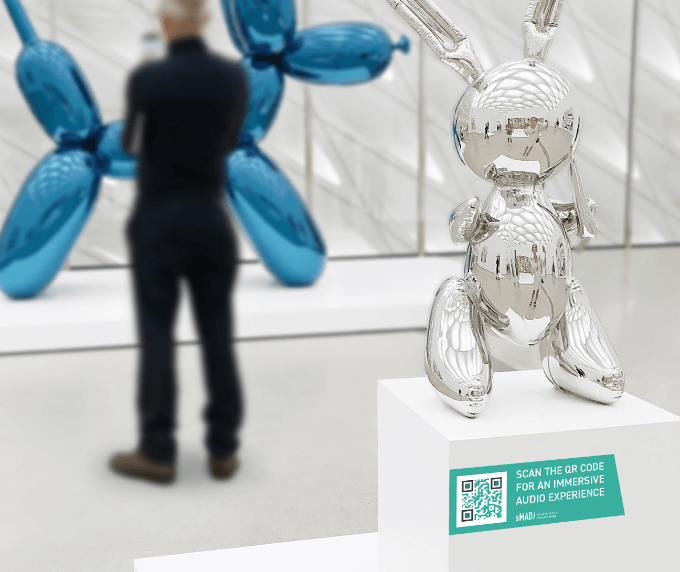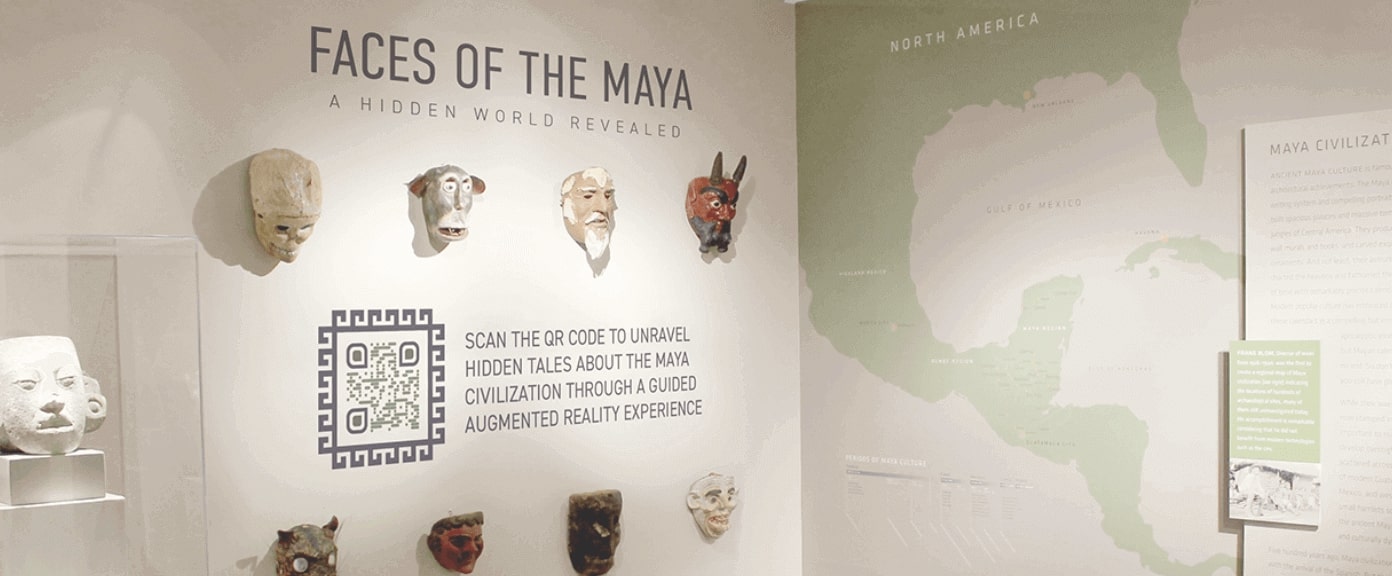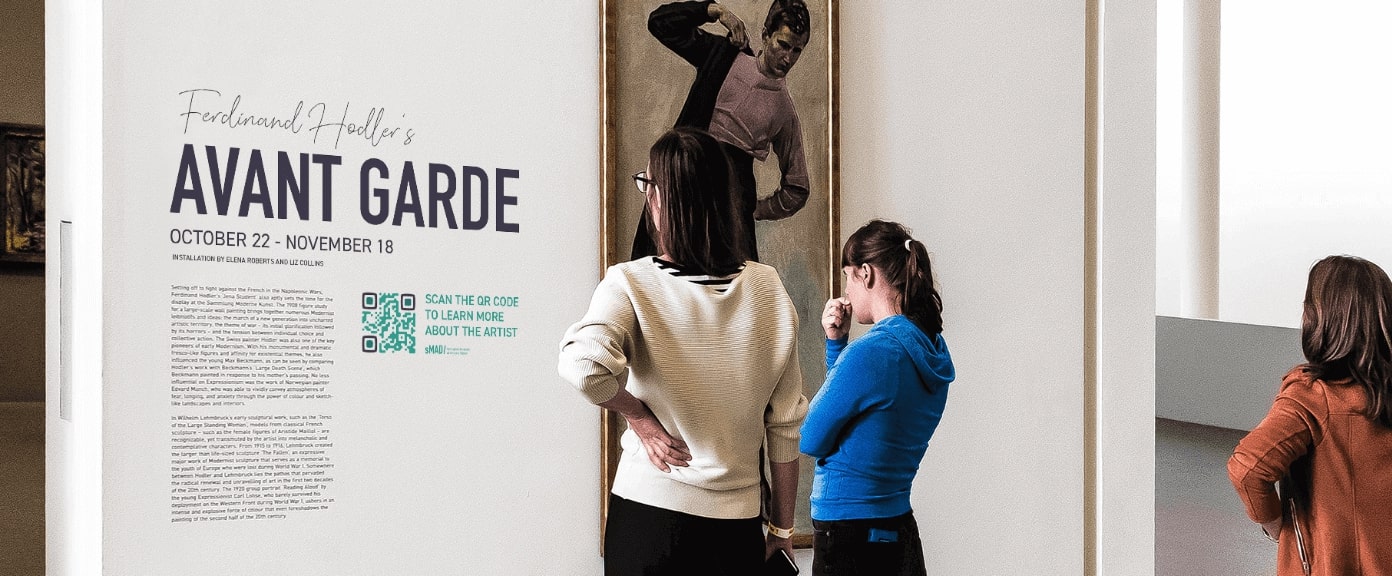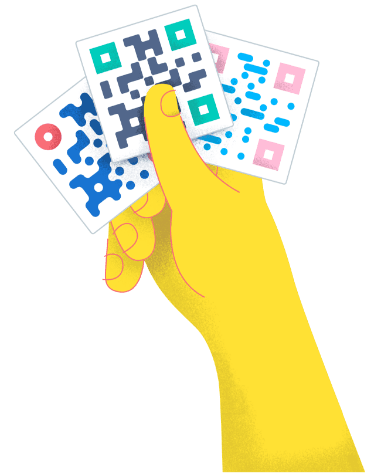- Benefits ●
- Best Practices ●
- Use Cases ●
- FAQ ●
Whether it is to promote new exhibitions, student art portfolios on business cards, or to create more engaging museum tours, QR Codes have made a definite impact on the art world. And with more flexibility when it comes to QR Code design, it has made them easier to integrate into illustrations, logos, and any art medium.
The benefits of applying QR Codes on art
Teresa Margolles’ new work El asesinato cambia el mundo / Assassination changes the world, is described as investigating the social and aesthetic dimensions of conflict by infusing artwork with material traces of violence and loss. One of these materials is a receipt reproduction of an ammunition purchase by the artist at the same Walmart where, on August 3rd, a 21-year-old man opened fire with an assault rifle and killed 22 people. The receipt shows the purchase of an ammunition box of 25 shells for $5.48, plus tax. Perhaps even more jarring than something as mundane as a receipt is the QR Code at the bottom, prompting customers to scan for Walmart coupons. Since QR Codes can be photocopied, Walmart’s scan & go mobile coupon still works. If visitors snap a picture of the receipt, as Siddhartha Mitter did, they are transported for a moment from the exhibit to the banality of everyday life: getting discounts on your grocery shopping.
Maybe all you know about QR Codes is their contribution to advertisement and information sharing, or as effective marketing tools. But their ability to mediate between the offline and online world makes them excellent tools for artists to help audiences explore new ideas by combining different mediums and offering a variety of perspectives.
1. Create a more inclusive art world
QR Codes can help you create new pathways in the pursuit of art. It gives you a unique set of tools to close the gap between different locations and increase accessibility to spaces not usually open to the general public.
Code the Dream in Durnham, North Carolina turned two murals on East Chapel Hill Street into digital portals, granting scanners access through the Mariposa AR app to the North Carolina Museum of Art exhibit honoring Diego Rivera and Frida Kahlo. By creating this project, Code the Dream increased accessibility to the museum, located in Raleigh, to anyone across the state who wasn’t used to visiting it often.
Perhaps one drawback was that people viewing the mural needed to have the app downloaded beforehand. QR Codes set-up an even more seamless scenario, where even those unaware of a digital access point in the physical world can still be included. The App Store QR Code, for instance, is an easy way to connect scanners to the app! It matches the mobile device’s operating system to the correct App store, enabling people to download it and partake in the experience instantly.
2. Amplify your art with QR Codes
You don’t always need an app to augment reality or create a more interactive experience. Take Germany, for instance, and the city of Münster’s LWL Museum exhibit on Turner: Horror and Delight. For the entire run, visitors could scan a QR Code that gave them access to a digitorial, a webpage that offered visitors a treasure trove of information on Turner, his life, travels, aesthetic, and style.
But QR Codes don’t just need to be digital doorways. You can offer different perspectives and views on a subject you are covering with a playlist stored in a Video QR Code. Or use the MP3 QR Code to frame a tableau with sound designed to recall a certain feeling. The different types of QR Codes are a resource that can help you give a more amplified voice to your ideas.
3. Easily integrate it into your aesthetic
QR Code Generator PRO gives you even more artistic flexibility when generating your own Codes. You can add individual brand colors with custom frames and edges, put a logo or image in the middle, and include a unique CTA (call to action). QR Codes are adjustable in size and image file type, so they can be made to fit any art medium you use.
4. QR Codes help you track, measure, and plan
Are people viewing your wall art? Interacting with it? Until now, that was perhaps one of the major drawbacks when it came to print materials or physical objects, which is the inability to track any kind of progress or action occurring between art and viewer. Especially in contrast with digital platforms. QR Codes have changed that.
When you use a Dynamic QR Code instead of a Static one, you can view real-time tracking data for any visual art media. Metrics such as location by city and country, time scanned, operating device used, and unique vs. total scans enable you to monitor how well your QR Codes are working and how you can improve them for the future, so you can really oversee every detail of your creative output.
How to create a QR Code on art?
- Go to QR Code Generator and select the type of QR Code you’d like for your art piece. We recommend starting with the URL QR Code.*
- Type in the website in the required field to link with your QR Code.
- Your QR Code will be generated automatically.
- Now, customize the design of your QR Code by adding a frame and a “Scan Me” logo.*
- Select colors to match your style.
- Select ‘Download’ to receive your QR Code file in .jpg format.
- Integrate your newly-created QR Code to any design.
*Sign up to create a Dynamic URL QR Code, where you have the option of adding more information, more visuals, and edit or replace information without reprinting a new QR Code, even after print. You can also choose from a variety of frames and upload your own logo for further branding.
QR Codes on art best practices
When designing your QR Code on art, there are a few valuable details to keep in mind so that your efforts get the best results. For more detailed instructions, visit our QR Code design guide.
1. Customize your design
It’s highly recommended to customize your QR Code with all of the styling options available. This helps QR Codes match your aesthetic.
2. Use the appropriate size
Using the right size for your QR Code ensures that there are no problems scanning your Code and that users can read it. QR Codes should be no smaller than 2 x 2 cm (around 0.8 x 0.8 in) because they can always be scaled up—even to the size of a billboard ad! We’ve also got four different image file types to download QR Codes to help you find the right size and image type to fit all designs.
3. Add a CTA
One big mistake QR Code users have made in the past is printing them without a short written explanation of what someone would gain or learn from scanning one. Make sure to incentivize viewers to scan your Code, or else all your efforts will be for naught.
See QR Codes on art in action
Need some inspiration to get the creativity going? Here are five use cases showcasing real-life QR Code ideas on art.
Diversify your income as an artist
Tag your public art with a Bitcoin QR Code to offset the costs of art materials and supplies. As the first decentralized digital coin, Bitcoin removes the middle man. Combined with QR Code technology, it makes it easy for anyone with a smartphone to point their mobile device at your art and donate to you. Don’t believe us? Pascal “PBOY”, a French street artist made $1,000 after adding a Bitcoin QR Code to his wall paintings.
Connect viewers to your online store
With a Dynamic URL QR Code, you can connect your exhibition directly to your online store. If visitors see an art piece they like, they can scan the QR Code and browse your store to order a print or the original, and have it delivered.
Promote yourself as a creative
Social media has had a huge impact on artists and how they promote their art. With the advent of Twitter and Instagram, a website might slowly become a thing of the past and the new museum halls might be self-curated social media platforms. But what if you have an exhibit in the physical world? Don’t just add a link in your bio, make a post with an Event QR Code, linking to a mobile-optimized page with all pertinent information interested people can save to their phones.
Provide more information about your art
Get viewers into your perspective with a PDF QR Code connecting them to what inspired you to create your work. Just upload a PDF to a Code either integrated or attached to your art so people can dive into the story and process behind your creativity.
Connect communities through augmented reality
You have an app for people to download so they can experience your art on a different level? You can connect viewers seamlessly from your art to different exhibits across the country with an App Store QR Code. It connects scanners instantly to any app store, so they don’t have to needlessly search to see if it is available for their smartphone operating system.
FAQ
With the different types of QR Code solutions available to you, you can put any kind of information from documents, to audio files, to an entire library of videos in order to enhance the viewers’ experience.
QR Code Generator has curated an excellent selection of payment options with QR Codes, either through our European Payments Council EPC QR Code, where you can initiate a SEPA credit transfer, or remove the middleman and be an early adopter with the Bitcoin QR Code.
Definitely! Once you have generated your chosen QR Code and uploaded all the necessary information you want to share, you get the Code in an image file. And once you have that template, you can get creative with how you display the QR Code, whether with trees or carved in stone.
Have more questions?
Visit our help center







 Add custom colors, logos and frames.
Add custom colors, logos and frames.

